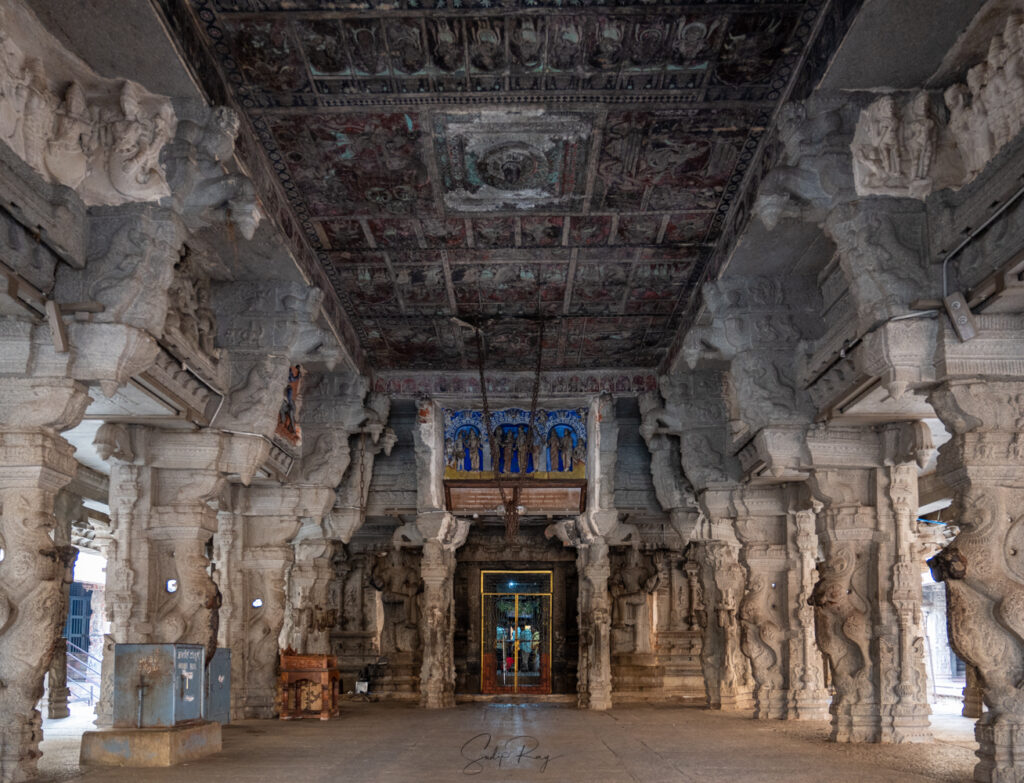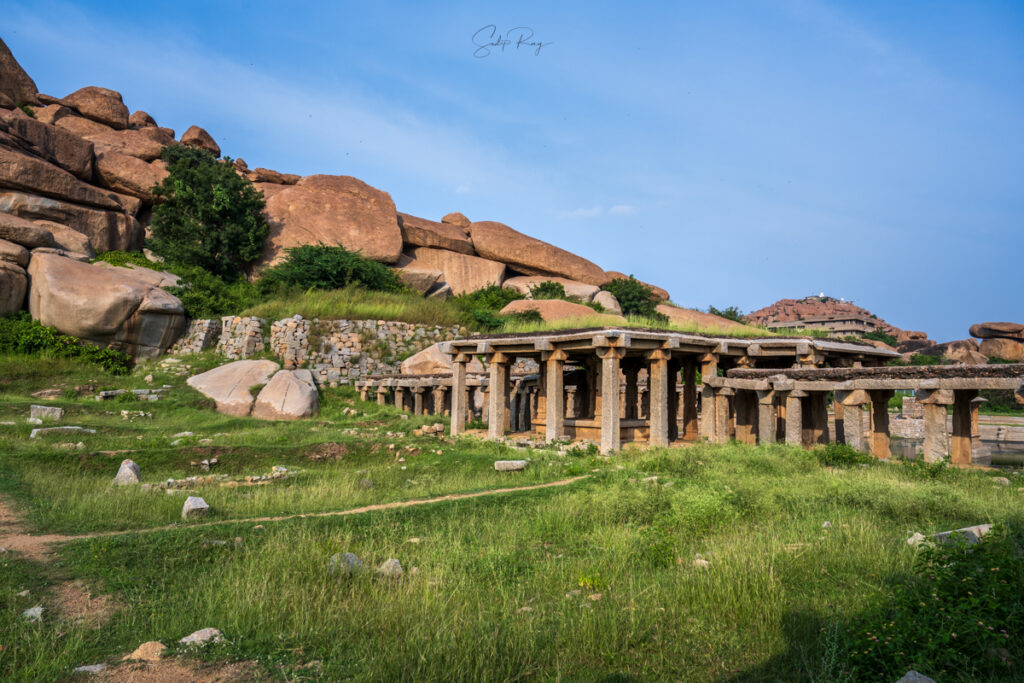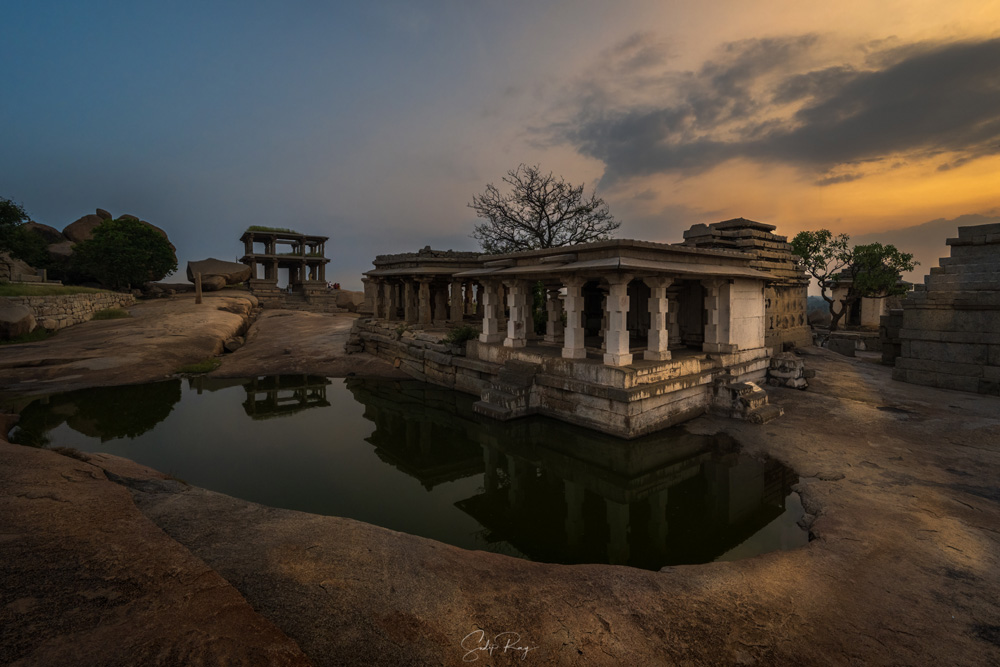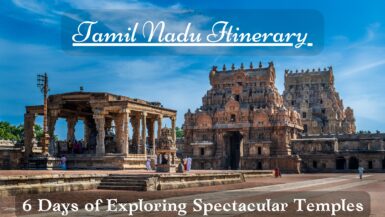Since time immemorial, Hampi has captured the imagination of many. During the prime of its life, Hampi had enamoured the many travellers who visited from faraway land to witness her unimaginable riches. Even now, when her best days are a legend buried in the past, she continues to attract visitors thanks to her prosperous as well as tragic history. In a word, Hampi is an enigma. She will cast a spell even before you travel there, allures you while you immerse yourself in her ruins, and her charm even continues to enchant you long after you have returned home.

Table of Contents
History of Hampi:
Hampi was initially known as Pampakshetra. It was named after Pampa, a reincarnation of Sati. Pampa had fallen in love with Shiva, who was then meditating at Hemkuta Hill. Eventually, Shiva was impressed by Pampa’s dedication and married her. In fact, Shiva is known as Pampapati in Hampi. Also, Hampi is a contorted term derived from the word ‘Pampa’.

In Ramayana, Hampi was called Kishkindha. It was the kingdom of monkeys. It was from here that Rama embarked on his mission to rescue Sita from Lanka.
Historically, Hampi was the capital of the mighty Vijayanagara Empire. It was the second largest city of the Medieval Age. It was also the richest city in the contemporary world. Foreign visitors from Persia, Italy, Portugal and Russia have left chronicles of a prosperous city, which was conquered by the Deccan Sultanate troops in 1565 CE, ravaged for six months and then abandoned.

You can read more about Hampi’s history and legend in our previous blog here.
Temples in Hampi:
Hampi is dotted with countless ruins of temples and royal establishments. At every bend of the road, you will come across stray colonettes jutting out from a bush, rickety gateways, or temples falling to pieces. In short, Hampi resembles an open-air museum, always on its toes to spill its glorious past to eager ears. Once the capital of the mighty Vijayanagara Empire, Hampi is now enlisted as a UNESCO World Heritage Site thanks to her architectural and sculptural remains.

The abundance of archaeological remains in Hampi may befuddle any first-time visitor. The ruins here are broadly classified into two groups – Sacred Centre, comprising of the temple and other religious remains, and Royal Enclosure, consisting of the relics of royal households and courts, and military buildings.
Here, we have outlined the 8 must-visit temples in Hampi:
1. Virupaksha Temple:
It is one of the few intact and active temples in Hampi, which remained largely unscathed from the destruction caused by the Sultanates. During the Vijayanagara Empire, it was the main temple and principal centre of pilgrimage in Hampi. Even today, throngs of pilgrims visit this temple every day.

The Virupaksha Temple is a typical example of the Vijayanagara period structure, although the entrance Gopura is a later addition dating back merely to the early 19th century. Some of the edifices are attributed to Krishnadevaraya, who commissioned them to commemorate his coronation in 1510 CE. The smaller Gopura inside the spacious rectangular courtyard and the 100-columned hall in the southwest corner are such structures.

However, the most stunning of them is the open ‘mandapa’, which is characterised by the striking originality of its architecture and carved decoration. It features cut-out colonettes, vigorously posed ‘yalis’, mythical ‘makaras’, etc. Moreover, the ceiling is beautified with splendid paintings showcasing various mythological incidences such as the marriages of Virupaksha and Pampa, and Rama and Sita, Kama aiming an arrow at meditating Shiva, and the like.

The temple is dedicated to Shiva, who is venerated as Virupaksha and Pampapathi here. He is represented here as a ‘mukha-linga’, with an embossed brass face mask. Along with him, his two consorts – Pampa and Bhuwaneshwari – are also worshipped here. The Goddesses are housed inside smaller shrines, placed north of the Virupaksha altar. In addition, the temple is dotted with numerous minor shrines dedicated to Mahishasuramardini, Adishesha, and so on.

2. Vijaya Vittala Temple:
Regarded as a masterpiece of Vijayanagara temple architecture, the Vijaya Vittala Temple is akin to an enigma. Nothing definite is known about its history. General consensus among scholars credits its foundation to the Tuluva dynasty in the early 16th century with structural additions by later emperors, their queens, courtiers, and officers. It was the nucleus of Vittalapuram, one of the main urban clusters of Hampi.


The splendid temple stands in a rectangular courtyard with Gopura’s on three sides, two of which were built by Krishnadevaraya’s queens in 1513. Dedicated to one of Vishnu’s heavenly forms Vittala, its sanctum sanctorum is now empty and devoid of any idol. Every part of this temple has intricate carvings that testify to the brilliance of the Vijayanagara sculptors and architects. Most of the carvings found here have Vaishnava theme. In addition, there is a trilingual inscription of Krishnadevaraya dated 1516 CE with Kannada, Tamil, and Telugu characters.


The magnificent stone chariot is evidently the cynosure of this temple complex. It is believed to be inspired by Konark’s Sun Temple. Originally a Garuda shrine with exquisite cut-out colonettes, this iconic structure is however incomplete. Interestingly, the stone chariot is featured proudly on the INR 50 note.

3. Krishna Temple:
One of the most significant temples of the Vijayanagara Empire, the Krishna Temple was the epicentre of the Krishnapura urban cluster. It was constructed by Krishnadevaraya to commemorate his victory over the Gajapati rulers of Kalinga. During its heyday, it housed a granite icon of infant Krishna, which was brought from the fort at Udaygiri (in present-day Andhra Pradesh).


Though the Gopura is now in a dilapidated state with most of its carvings defaced, its once grand scale can still be gauged easily. The main temple consists of a 25-bay open ‘mandapa’, an enclosed 9-bay ‘mandapa’ with side porches, and a towered sanctuary surrounded by a passageway.
The temple also has an inscribed slab detailing the military expeditions and benefactions of Krishnadevaraya.

4. Hazara Rama Temple:
Literally meaning ‘temple of thousand Ramas’, the Hazara Rama Temple is situated at the core of the royal cluster of Hampi. Built under the patronage of Devaraya I, it was consecrated to Ramachandra and served as the royal temple for the Vijayanagara rulers.

The most outstanding feature of this temple is the three tiers of carvings on the outer walls, featuring 108 scenes from the epic Ramayana. The sculptures proceed in a clockwise direction around the walls. They begin with Valmiki telling the story to a king and the fire sacrifice performed by Dasaratha and end with the triumphant coronation of Rama at Ayodhya.

Further, the exterior of the compound walls of the temple are decorated with intricate carvings, depicting military processions, celebration of Vasantautsava or spring festival and Mahanavami festival, and so on. Curiously, no two human or animal figures are identical here.
In stark contrast, the interior of the main temple is somewhat austere. The exceptions, however, are the four columns wrapped in ornate carvings of the 24 aspects of Vishnu along with several Ramayana characters.

5. Malyavanta Raghunatha Temple:
Located a tad bit away from the usual tourist circuit of Hampi, the Malyavanta Hill is laced with tales from Ramayana. It is believed that, while looking for Sita, Ramachandra had spent four months here. The relief carvings of Shiva lingams and Nandis found on the hill were worshipped by Rama himself.

At the summit of the Malyavanta Hill stands the beautiful Raghunatha Temple. Interestingly, this is the only temple in India where Rama is worshipped in a seated position.

In addition, the top of Malyavanta Hill provides a captivating panoramic view of the entire Hampi.

6. Pattabhiraman Temple:
One of the least visited temples in Hampi, Pattabhiraman Temple was probably commissioned by Achyutaraya. Dedicated to Ramachandra, it once formed the nucleus of an urban cluster called Varadevi Amman Pattana, named after one of the queens of Achyutaraya.

The temple represents the standard Vijayanagara style of temple architecture. It stands in the middle of a vast paved courtyard. It consists of an open ‘mandapa’, an enclosed ‘mandapa’ with side porches, and a sanctuary encircled by a passageway. Though it lacks fine sculptural details like its counterparts elsewhere in Hampi, the Pattabhiraman Temple is impressive for its scale, elegant proportions, and long elevation. Moreover, the moss-covered Gopura on the east exudes an Angkor Watesque vibe.

7. Achyutaraya Temple:
Contrary to what its popular name suggests, this crumbling temple complex was built, not by Achyutaraya, but by his brother-in-law, Hiriya Tirumalaraja. As such, its original name is Tiruvengalanatha Temple. Back in its crowning years, it formed the core of Achyutapura, another urban cluster of Hampi.

The Achyutaraya Temple is in a decaying state, with its twin Gopura almost levelled down by the Sultanate perpetrators. Yet, its grand scale and magnificence can still be asserted from its rubble.
The structure of this temple bears a resemblance to its other counterparts and represents the usual Vijayanagara-styled sequence of open ‘mandapa’, closed ‘mandapa’ with side porches, and a sanctuary surrounded by an unlit passageway. Few brilliant sculptures of Vaishnava theme on the pillars and door jambs have survived the ordeal of time.

8. Ganagitti Jain Temple:
It is perhaps the only Jain temple in Hampi and hence worth a mention here.
An inscription of 1385 CE on the ‘dipa-stambha’ right in the front of the temple mentions that this Jain temple was built by Irugappa, a general of Harihara II.

The temple is simple in structure and spartan in style. It is distinguished from the other grander and more ornate temples of Hampi by plain outer walls and a stepped pyramidal stone tower.
In addition to this, you will find innumerable shrines at Hemkuta Hill, Matanga Hill, and the Tungabhadra riverside.

Important FAQs:
A. Where is Hampi located:
Hampi is located in central Karnataka, near the state border with Andhra Pradesh. It is situated on the banks of the Tungabhadra River. Hampi is 376 km from Bengaluru and 165 km from Hubli.
B. How to reach Hampi:
- By air: The nearest airport is at Torangallu (32 km from Hampi), which, in turn, is well–connected with Bengaluru by air.
- By rail: Hospet (13 km from Hampi) is the nearest rail station.
- By bus: Overnight bus services are available from Bengaluru.
As for us, we reached Bengaluru from Kolkata by flight. Then, we boarded the train from KSR Bengaluru station. We reached Hospet at 7 AM after an overnight journey. From Hospet, we took an auto to Hampi. The auto charged INR 250.

C. What is the best time to visit Hampi:
Given its rocky terrain, Hampi remains excruciatingly hot during most part of the year making it extremely difficult to explore the ruins. Hence, it is best to visit Hampi from October to February. Temperature remains moderate and chances of rainfall are almost nil during this time.
D. Where to stay in Hampi:
The KSTDC Mayura Bhuvaneshwari at Kamalapura and Clark’s Inn Hampi near the Archaeological Museum are two great options for accommodation in Hampi.
E. How to travel within Hampi:
The most convenient way to travel in and around Hampi is by auto. The daily fare of an auto is around INR 1000. Don’t forget to bargain a bit.
You can rent scooters and bikes at INR 200 – 300 per day depending on the type of vehicle.
You can also rent bicycles at INR 100 – 150 per day.

F. How many days are enough for Hampi:
Ideally, 3 days will be sufficient to explore Hampi. We spent 3 days and covered even some of the off-beat places in Hampi. For a detailed itinerary of Hampi, check out our blog here.
G. Few tips to remember:
1. The temples in Hampi remain open from 6 AM to 6 PM.
2. Entry fees are required for Virupaksha Temple and Vijaya Vittala Temple. For the rest of the temples, entry is free.
3. Drones and any kind of tripods are not allowed in Hampi.
4. The weather in Hampi is quite hot even at the end of October. Hence, we suggest starting as early as possible. Explore until lunch and take a break afterwards as the sun remains harshest between 12 PM to 3 PM. Start travelling again after 3 in the afternoon.
6. It is unsafe to travel around Hampi after sundown. Bears and leopards lurk around the hills and caves in the darkness.
7. Though the ambience of Hampi is quite chilled out, we suggest dressing modestly as most of the monuments in Hampi are religious in nature.
8. Carry an umbrella, wear hats and sunglasses, and drink plenty of water. Keep yourself hydrated with coconut water, which is readily available in Hampi.
9. Carry sufficient cash as ATMs in Hampi are mostly non-functional.
10. Both vegetarian and non-vegetarian food options are available in Hampi. The restaurants around Hampi bazar however serve only veg. Some of the best eateries in Hampi are Mango Tree, Gopi Roof Restaurant, Ganesh Old Chillout, Funky Monkey, The Bridge and Laughing Buddha.
11. We would suggest taking a guided tour of Hampi. It will make your tour more organised and you will get to know countless titbits about Hampi. We hired Mr. Bhanu. He was an excellent guide. He charged us INR 2000 per day. His contact number is 09449409070.



